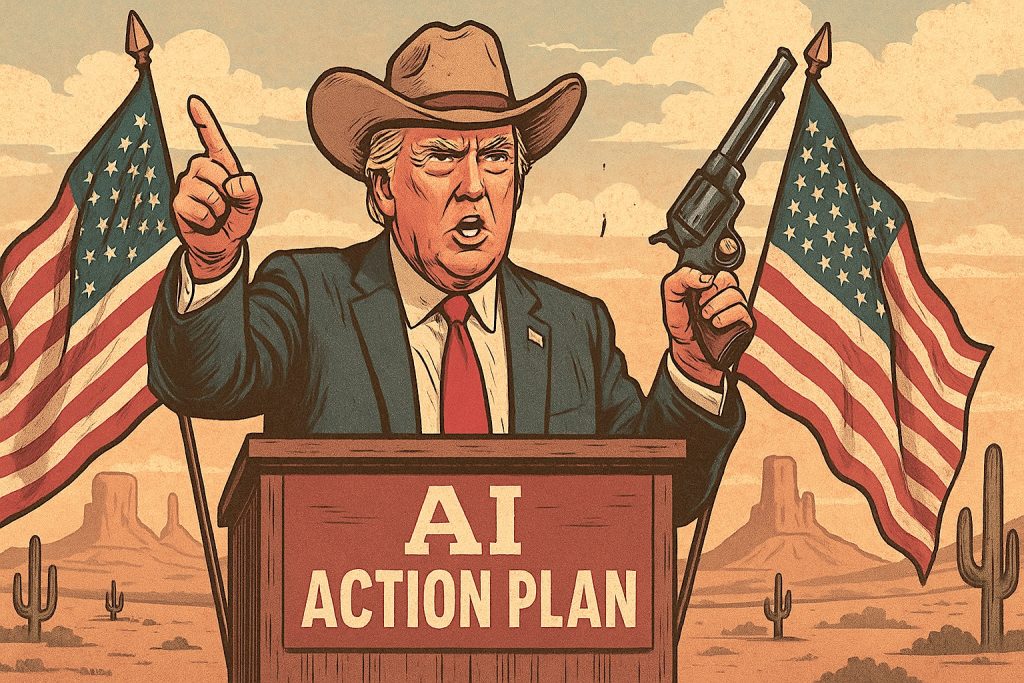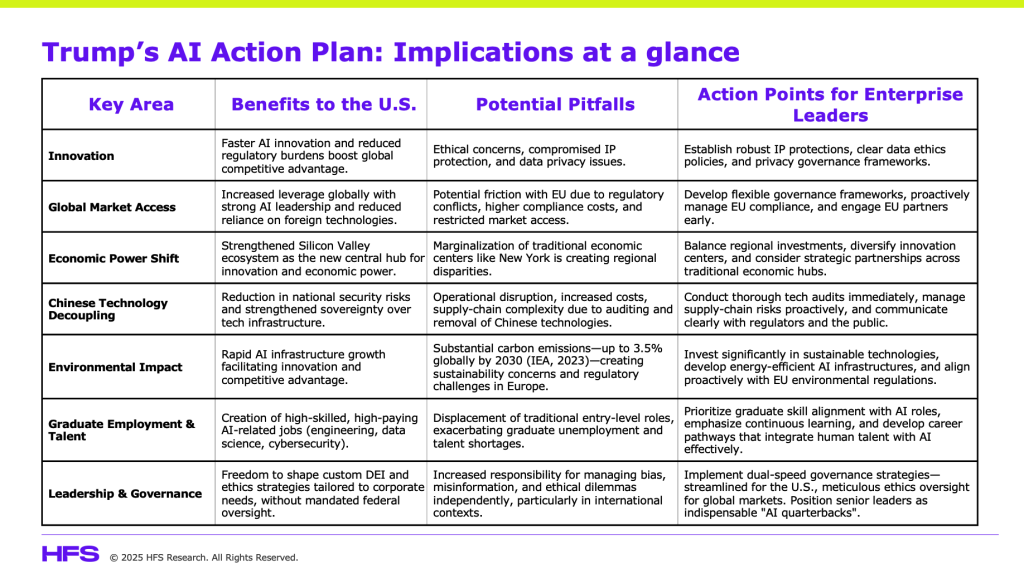
Love him or loathe him, let’s be clear… President Trump’s new AI Action Plan isn’t just political theatre, it’s a strategic sledgehammer aimed at reshaping the global AI landscape in America’s favor. This is your wake-up call, whether you’re leading a tech firm or steering an enterprise. Align with the American AI stack, or prepare for a long ride in the slow tech lane.
Accelerating innovation and removing regulatory shackles
America is taking its foot off the regulatory brakes, although this could amplify ethical risks, reduce content protection, and potentially compromise data privacy as it seeks to become the undisputed AI leader. Trump’s vision is simple: remove barriers, build massive infrastructure, and force global alignment with US-controlled AI tech stacks and data centers. Forget subtlety, this is an aggressive, competitive manoeuvre driven by Trump’s showman antics!
Silicon Valley becoming America’s power center
With copyright protections sidelined and regulations slashed, the Valley is primed to dominate this AI-fuelled gold rush. However, this raises critical concerns, namely uncontrolled content exploitation by AI bots that could severely damage intellectual property rights, trigger extensive copyright litigation, and create significant ethical dilemmas related to data privacy and fairness. Additionally, this push reinforces a significant power shift toward Silicon Valley and away from traditional economic hubs like New York, further consolidating influence around tech giants at the expense of traditional finance and media sectors.
America’s free-for-all approach is in stark contrast to Europe’s regulatory quagmire
Europe’s AI Act emphasizes caution, human oversight, and sustainability, which could prove to be deadly slow in the AI arms race. Trump’s strategy couldn’t be more opposite by promoting innovation, accelerating infrastructure, and accepting (or just ignoring) inherent risks. For ambitious enterprises seeking to drive AI-first business and talent strategies, the choice is stark… bet on the fast-moving, albeit riskier, American stack or struggle through Europe’s costly and stodgy compliance maze.
This AI Action Plan could also create challenges for American firms dealing with European firms, in terms of meeting their compliance requirements, potentially increasing operational complexity and legal risks. Also, with Europe tightening controls and potentially imposing import taxes on tech services from countries not complying with its regulations, American enterprises might face higher costs, restricted market access, or increased scrutiny when serving European customers.
To mitigate these issues, American enterprises should proactively develop flexible, robust governance frameworks capable of adapting to both markets, clearly communicate compliance and ethical strategies, and engage directly with European partners to address potential concerns early.
Audit your tech stack immediately for Chinese influence
With Trump’s renewed emphasis on national security, enterprises must urgently audit their tech stacks. Firmware, data sources, and LLMs originating from China, such as DeepSeek, ERNIE Bot, Manus Tongyi Qianwen, 360 Zhinao, SenseFace, and Tencent, will be considered toxic. Be ready to answer regulators’ tough questions or face uncomfortable public scrutiny. Keep in mind, however, that auditing and removing Chinese technology can present significant operational challenges, including service disruptions, increased costs, and potential supply-chain complexities.
Take charge of your DEI and ethics strategy independently
The Trump administration is explicitly stripping DEI and ethics mandates from federal frameworks. This gives enterprises both freedom and responsibility, where US firms must now manage their own bias and misinformation risks, especially when operating internationally. Prepare for a dual-speed governance approach that tackles streamlined security for the US market with meticulous ethics and compliance for Europe.
Address the environmental cost of rapid AI expansion
The global environmental impact of AI infrastructure growth is immense. AI data centers alone could account for up to 3.5% of global carbon emissions by 2030 (source: International Energy Agency, 2023), which is even more than the emissions from the global aviation industry today. Enterprises racing to expand their AI capabilities must grapple with sustainability concerns as energy consumption and environmental footprints skyrocket.
American firms relying heavily on carbon-intensive AI infrastructure could struggle to comply with EU sustainability requirements. This scenario could raise operational costs significantly, making American solutions less competitive or less attractive to European partners who prioritize sustainability compliance.
Lean into both your developing human talent and AI ambitions to create a unique company culture and identity
The AI Action Plan presents significant implications for graduate employment and entry-level jobs in particular. On the positive side, increased investment and rapid innovation in AI technology will likely create new categories of high-skilled, high-paying jobs, particularly in AI engineering, data science, and cybersecurity. Graduates who acquire specialized AI-related skills will have considerable advantages in the job market.
However, there’s also a downside. Automation and AI could displace entry-level positions traditionally filled by recent graduates, potentially exacerbating graduate unemployment rates and creating a gap in career pathways. Enterprise leaders should proactively invest in young talent by aligning graduate recruitment with evolving skill requirements, emphasizing continuous learning, and developing pathways that enable graduates to work creatively and effectively with AI tools. Lean into both by creating roles that complement AI—focusing human effort on critical thinking, creativity, ethics oversight, process and systems governance, and innovation management.
The US has several robust training initiatives underway to support AI workforce development. These include NSF-funded National AI Research Institutes focused on sector-specific skills, the Department of Labor’s AI Apprenticeship Program emphasizing practical AI training, the Department of Commerce’s AI Centers of Excellence facilitating industry partnerships, and Workforce Innovation Grants aimed at boosting AI education in community colleges and regional institutions.
Become an AI quarterback and an indispensable leader
Business leaders must proactively position themselves as indispensable AI quarterbacks within their organizations. This involves developing a deep understanding of AI capabilities, limitations, and strategic implications for your business. Act as a bridge between technical AI teams and broader organizational strategy, effectively translating complex technical details into clear business insights.
Leaders should prioritize AI literacy, invest in executive education, and champion AI-driven initiatives across all departments. Foster a culture of curiosity and agility, encouraging your teams to experiment and iterate quickly. Your ability to lead AI transformations, manage risks, create smart governance frameworks, and leverage technology strategically will make you essential to your organization’s future success.
Bottom line: Invest hard, move fast, and exploit this AI freedom
Trump’s AI Action Plan signals permission to innovate aggressively. Push the limits, break the mold, and stop waiting for global consensus. This is your moment to place your big bets on AI with Uncle Sam’s backing, which means speed and boldness trump caution and inertia. Hesitate now, and you risk irrelevance.
Posted in : Agentic AI, AGI, Artificial Intelligence, Change Management, Economics and Geopolitics, GenAI, Generative Enterprise






